Nearly every organism that lives in or around the sea is a potential food source. Emergency rations should not be used as a primary source of food, but should be used to supplement whatever food can be obtained from the environment.
TEST FOR EDIBILITY
Before consuming any type of fresh food that you are not absolutely certain is safe, always test for edibility with very small portions of the food. You will probably, at one time or another, experience some degree of food poisoning. But if you utilize the following test for every source of food, the chances of severe poisoning will be greatly minimized. This test does not apply to food that has been spoiled.• Touch the food to the tip of the tongue. if it burns, stings, or tastes bad, throw it away and wash your hands immediately.
• if it tastes acceptable, leave a little in the mouth for five minutes. if you have no adverse reaction, then swallow it, and wait one hour.
• If there is still no reaction, eat a small serving and wait another hour.
• if you have not had any adverse reactions to the food after testing it, then it should be relatively safe to eat since most poisons (except those caused by spoilage) will produce symptoms within a very short time.
• if no adverse symptoms occur within 12 hours after eating a small portion of the food, it can be considered edible.
• Do not assume that all fish of the same species are edible (particularly those species in which ciguatera poisoning might be suspected). A test should be applied to each fish before consuming it.
• If there is any doubt about the edibility of a food source, throw it out. Don’t take any chances.
PLANKTON AND SEAWEED
Seaweed
Many seaweeds are edible, and are a nutritional food source. Seaweed should be washed in fresh water before being eaten, and can be eaten raw or dried. (Some types of seaweed are poisonous, so an edibility test should always be applied.) The ingestion of seaweed requires gradual adaptation because of the laxative quality of its high cellulose content.
The leafy green seaweeds can be easily dried for storage, and are a good source of protein and carbohydrates. The value of encountering pieces of seaweed floating in the open sea is that tiny animals (small fish, crabs, and shrimp) can be found clinging to them. These fish are excellent sources of food or bait, and are easily dislodged by shaking the clumps of seaweed.
Plankton
Plankton includes minute plants and animals that drift about in the ocean. The nutritional values of plankton are high, but because of their high chiton and cellulose content they can not be digested in large quantities. There are also toxic species that can be hard to detect. It is therefore not advisable to consume plankton in the survival situation other than as a last resort, always applying an edibility test before consuming it.
• If it is necessary to use plankton as a food source, you must have a sufficient supply of fresh water for drinking.
• Plankton can be caught by dragging a fine woven net or cloth through the water. It can be eaten raw or cooked.
• The gelatinous plankton species should be discarded, since their tissues are composed primarily of salt water.
• Examine the catch and sort out any broken stinging jelly fish tentacles that you might have inadvertently caught.
• Be cautious of consuming plankton in the areas and sea Sons where red tides are known to occur.
SHELLFISH POISONING
Red Tides
Red tides are caused by the proliferation or sudden “bloom” of minute species of plankton called dinoflagellates. These planktonic algae are toxic to man. The plank ton “blooms” also cause paralytic shellfish poisoning, which can be fatal. It is transmitted to man by ingesting shellfish that have been feeding in red tide areas.
Red tides occur in waters above 30 degrees north latitude and below 30 degrees south latitude. Most out breaks occur between May and October, when water temperatures are the highest. Survivors in tropical waters, or those in temperate waters during the winter months, need not be concerned about the occurrence of red tides.
It is important to note that poisonous shellfish cannot be detected by their smell or appearance. Mussels, clams, oysters, and scallops are the main vehicles of transmission.
this.
Because of the severity of the poisoning, preventive measures are extremely important.
Symptoms of Paralytic Shellfish Poisoning
• Tingling of the lips, mouth, face, and extremities frequently accompanied by nausea and diarrhea
• Muscle paralysis and respiratory impairment in more severe cases
Most symptoms usually appear within 30 minutes of ingesting a toxic mollusk. Most deaths occur within the first 12 hours of illness from respiratory paralysis.
Treatment
Induce vomiting to clear the gastrointestinal tract as soon as possible. Place victim lying down out of the sun. Artificial respiration might be required in severe cases.
FISH
Fish is a nutritious source of food, rich in protein as well as other minerals and elements. Ocean fish can be eaten raw. Fresh water fish should never be eaten raw, because they can introduce parasites into your digestive system. Cooking fresh water fish first is the only method of preventing
Spoilage
Fish spoils within hours without any means of refrigeration, particularly in warm tropical climates. Freshly caught fish should be placed out of direct sunlight and should be cleaned immediately. All fish that is not immediately cleaned and eaten or preserved may spoil within three to six hours. Do not eat fish that is suspected of being spoiled.
• Do not eat fish with an offensive odor (especially around the gills or belly), or that appear excessively slimy with a dull looking skin.
• Do not eat a fish if the flesh remains deeply indented when pressing in on it with the thumb, it is probably stale.
• if a fish has a sharp or peppery taste, it should be discarded. This is especially true of ocean fish with dark-colored flesh.
• Do not eat fish that have been left in the sun more than two hours without having been gutted and preserved.
• Cooking cannot be relied upon to make spoiled fish safe to eat.
• Do not eat the skin, head, or internal organs, especially the gonads and liver, of any fish you do not know for certain to be entirely edible. The liver, gonads, brain, and other organs can be poisonous in an otherwise edible species of fish. They should always be given the edibility
test.
POISONOUS FISH
Poisonous fish are widely distributed throughout the world, but are most common in tropical and semitropical waters, particularly in the tropical Pacific and the West Indies. As a general rule, most poisonous fish are found in shallow waters around shoals, reefs, and inlets. Therefore, the safest fish to eat are those from the open sea or deeper water beyond reefs. In open ocean situations, spoilage, rather than poisoning, will usually be your main concern.
Fresh fish that are poisonous to eat fall into two categories: those that are inherently poisonous, and those that develop toxins when their diets include toxic materials, the most common being ciguatera toxins.
Inherently Poisonous Fish
Fish that are inherently poisonous are easy to recognize and should never be eaten. They include:
• Porcupine fish, which can puff up and are covered with spines
• Puffer fish, which can swell up and become balloon-like
• Sunfish (molas), which look like a large head with no tail or body section (Figs. 8-1 through 8-3)
As a rule, avoid eating any type of fish that has spines or bristles instead of scales.
Toxic Ciguatera Poisoning
Ciguatera poisoning is the most prevalent type of poisoning known. Almost any fish living in the sea can be a potential carrier of ciguatoxin, although it occurs mainly among inshore fish of tropical and subtropical islands. There is no way to detect a toxic fish by its appearance, and the toxin cannot be destroyed by any method of rinsing or cooking.
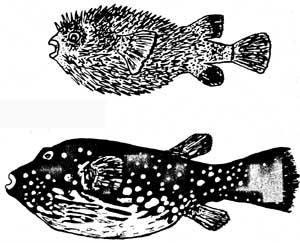
Fig. 8-1 Porcupine fish; Puffer fish (below)

Fig. 8-3 Ocean Sunfish/Mola mola
Geographical distribution does not give adequate warning of toxicity. Toxicity can vary from one locality to another. The same species of fish on one reef that is edible can be found to be toxic in an adjacent reef. Ciguatera poisoning is thought to be caused by toxic coral vegetation that bottom fish feed on. Consequently, ciguatera builds into the whole food chain in a cumulative manner

Fig. 8-4
Ciguatoxin poisoning occurs through the food chain. Biogenesis
of Giguatoxin: Toxic
Choral containing Toxic Precursor; Toxic Reef Fish Feeding on and Around Corals; Toxic Carnivore from feeding on Toxic Reef Fish or Eaten by Humans;
Precautions. In a tropical area known to have ciguatoxic fish, take the following precautions when eating reef fish:
• Do not eat large predatory fish that may have fed on other toxic fish (barracuda, snapper, grouper, amberjack, and moray eels). These are most dangerous, because of their larger concentrations of accumulated toxins. A good rule of thumb is not to eat any fish over 30 inches in affected areas, since large fish have a higher concentration of toxins.
• Be extremely cautious of bottom dwelling shore fish near reefs. These are most likely to be toxic, and include such species as surgeonfish and parrotfish, as well as mullet, triggerfish, and porgies (especially fish with a parrot-like beak). More than 400 species have been reported as ciguatoxic at one time or another (Figs. 8-5 through 8-9).
• Never eat the liver, intestines, roe, and head of reef- dwelling fish, since these have the highest concentration of toxins. Be careful not to puncture the innards when cleaning fish, toxins can spread to the flesh.
• Always apply an edibility test before eating. Always eat small portions, since toxicity is directly related to the amount eaten.
• Eat fish only once or twice a week, since the toxin has a cumulative effect. Fish that are only mildly toxic in them selves can add up to give a severe intoxication over a consecutive period of consumption.
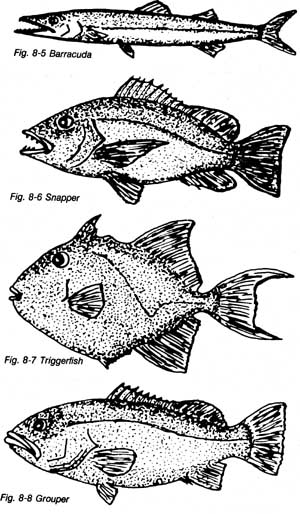
Fig 8-5-8

Fig 8-9
• Soaking the fish in several changes of seawater, or bringing it to a boil several times in different water may reduce some of the toxins, but this is not always reliable. It is only a precautionary measure at best.
Symptoms. Some common symptoms of nonbacterial fish poisoning include:
• Abdominal pain, vomiting, and diarrhea
• Tingling and numbness of the lips
• Dizziness and weakness
In severe cases, symptoms are pronounced and can lead to muscular paralysis and convulsions. Coma and death from respiratory paralysis can occur, although this is somewhat rare.
Ciguatera can develop in about 3 to 5 hours after the fish is eaten. All of the symptoms except for the feeling of weakness will generally subside within 24 hours.
Treatment. The stomach should be emptied immediately to get rid of any remaining poison. After that, alleviate the symptoms as best you can. Antihistamines may relieve the itching, and rest is recommended.
STINGING FISH
Survivors floating in the open ocean will have little cause to worry about the following species of stinging fish, since they are all reef dwelling and bottom dwelling creatures. If, however, you are stranded near a shoal area and foraging for food among the reefs, be extremely cautious of encountering fish with stinging spines and venomous glands.
Toxicity can vary between species and individual fish but the following groups of fish are known to be hazardous:
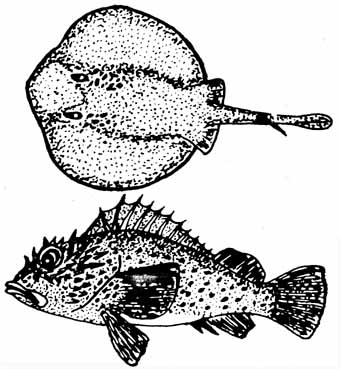
Fig. 8-10 Stingray (top); Scorpionfish (bottom)
• Stingrays
• Catfish
• Weeverfish, toadfish, and stargazers
• Surgeonfish
• Stonefish, zebra fish, and scorpion fish
Observe the following precautions regarding species of fish with spines that can cause puncture wounds and that may contain venom:
• Wear foot protection when wading in shallow water. Most spiny fish will not move from your path.
• Slide your feet with a shuffling motion when wading along muddy or sandy bottoms to avoid stepping on sting rays or other sharp-spined fish.
• Do not stick your bare hand into ledges or holes. Always use a stick.
• Avoid handling fish with venomous spines even after the fish is dead, since the spines can remain toxic.
If the poison glands are removed, the flesh of some venomous species may be edible. The hazards involved in removing the spines and glands make them an impractical food source.
First Aid for Venomous Puncture Wounds
• Cleanse and flush the wound immediately.
• Place the wounded area in hot water (as hot as the victim can stand) or use hot compresses for 30 to 60 minutes to deactivate the toxins.
• Cut out sting ray barbs because the barb is shaped like an arrow point.
MORAY EELS
Tropical eels should never be consumed, because they are known carriers of ciguatoxins. Moray eels in temperate and cold-water climates, or in areas known to be unaffected by ciguatera poisons, are edible, and the light, chicken-like meat can be consumed after the skin has been removed.
The aggressive reputation of the moray eel is generally exaggerated as a marine hazard to man, but suffice it to say a moray eel has sharp, pointed teeth and will defend its territory when provoked. Morays live in holes and crevices, so never reach into an underwater hole without first checking it for eels. The bite is not toxic, but is easily infected and can be difficult to heal in humid, tropical areas (Fig. 8-12).

Fig. 8-12 Moray eels, when provoked or surprised around shallow reefs
can inflict puncture wounds.
SHARKS
Of the more than 350 species of sharks, there are only about 24 that are considered dangerous to man. The presence of shark is commonly reported by castaways in survival platforms. However, they are often reported as more of a nuisance than an actual hazard, due to their tendency to bump and bang against the underside of a life craft (Figs. 8-13 through 8-16).
The majority of shark attacks occur in tropical waters, but this may be simply because more people swim in warm waters than in cold waters. While it is not known what actually motivates shark attacks, a desire for food and defense of territory seem to suggest the strongest motivations.
Exercise preventive measures in shark-infested waters to eliminate the stimuli that attract sharks:
• Avoid erratic movements, which produce sound waves underwater.
• Stay out of water where fish, animal blood, or offal have been dumped, these odors may attract sharks. Only dump offal when you are underway.
• Avoid trailing any part of your body in the water, such as dangling arms or legs from a life raft.
• Discourage a shark that threatens to attack or damage the life raft, jabbing at its snout or gills with an oar.
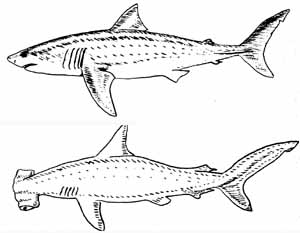
Fig. 8-13-14 Great White Shark; Hammerhead Shark
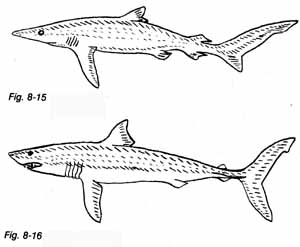
Fig. 8-15
Blue Shark; Fig. 8-16 Mako Shark
Shark Repellent
New shark defenses are continually being tested, but as yet, nothing has been found to be foolproof. The shark screen is one of the most promising deterrents. It is com posed of an opaque plastic bag with several inflatable flotation collars that protect the enclosed swimmer by eliminating most of the sounds, smells, and visual stimuli that attract sharks. A black plastic bag, large enough to envelop a person, can also be improvised to do the same thing.
Food
Shark meat is a good food source. It can be eaten raw, dried, or cooked. Although most sharks are edible, the flesh of tropical and arctic sharks should only be eaten with caution. In many cases, the flesh might be mildly toxic, and can cause gastrointestinal upset and diarrhea. Shark meat spoils rapidly, because of the high urea content in the blood. The meat should be bled immediately or soaked in several changes of water.
The most severe forms of poisoning usually result from eating shark liver, which can cause nausea, diarrhea, muscular paralysis, and even death. It is a good idea to avoid eating any shark liver, unless you are absolutely sure that it is edible. Unlike most other fish, the spinal column of a shark contains no fluid.
OTHER MARINE HAZARDS
Jellyfish and Portuguese Man-of-War
These sea creatures can usually always be found floating on the surface of the water. Some jellyfish and all Portuguese man-of-war are capable of inflicting painful stings that may cause allergic reactions in some individuals. Sea Wasps are an extremely dangerous, though un common, jellyfish that inhabit the waters around Australia, the Philippines, and the Indian Ocean. Their sting can be fatal; death can occur within seconds or minutes (Fig. 8-17).

Fig. 8-17 Some types of open ocean jellyfish, such as the Portuguese
man-of-war, can inflict serious stings on the unwary swimmer.
Treatment. Several methods for treating jellyfish stings have been recommended by medical authorities:
• Remove the tentacles; gently pull the tentacles off the skin, or shave the area with a razor or knife. Never rub the tentacles with sand or a towel.
• Apply alkaline solutions to the area to help neutralize the toxin. Ammonia, urine, sodium bicarbonate, meat tenderizer, papaya juice, or any liquid with a high alcohol con tent can be used. Apply a hot water compress or immerse the area that was stung in hot water to deactivate the toxins.
• Apply an alkaline solution to the affected area prior to removing the tentacles, to prevent additional irritations during their removal. Then apply a drying paste (powder, flour, or dry sand) to the skin, and scrape it off the skin along with the stinging cells.
• Treatment for shock or respiratory difficulties may be necessary if a severe reaction develops.
Sea Snakes
Sea snakes are highly poisonous, and are found only in the Pacific and Indian oceans. They vary widely in color patterns, but are snakelike in appearance and are best identified by their vertically flattened tail and scaled body. Their small mouth and non-aggressive nature usually makes them less dangerous than many land snakes, but their venom is about ten times deadlier than any other snake.
Sea snakes are edible, once the head containing the venom glands has been removed. Handle a sea snake with extreme caution. They are commonly eaten in many areas of Asia.
Sea Urchins
Sea urchins are abundant around reefs and rocky shore areas worldwide. Any sea urchin can be hazardous if accidentally stepped on or brushed against because they have slender and sharp spines, which become imbedded in skin. The danger of infection, in tropical areas, is a particular hazard with sea urchin wounds.
Treatment. If a puncture wound occurs from a sea urchin, extract those spines that are easily removed. Dissolve the rest by applying ammonia, alcohol, or citrus juice. Diesel fuel and urine have also been reported to be effective.
Food Source. Sea urchin roe is considered a delicacy, and may be eaten either raw or cooked. The roe sacs can be extracted by slicing through the sea urchin with a heavy, sharp knife and carefully removing the brightly colored (yellow or orange) clusters of eggs.
Cone Shells
Poisonous species of cone shells are most commonly found in the tropical Indian and Pacific Oceans. Those shells with a textured color pattern or a red proboscis are most likely to be toxic. The open end of the shell may contain a poisonous, hypodermic-like tooth, which can pro duce acute pain, swelling, paralysis, blindness, or even death, in less than three hours.
Cone shells are found under rocks, in crevices of coral reefs, and along rocky shores or protected bays. Avoid handling any shells that look like cones (Fig. 8-18).

Fig. 8-18 When foraging around shallow reefs, be cautious handling cone-shaped
shells.
Coral
Coral cuts are one of the most common hazards in tropical waters. The razor-sharp edges of coral can cause deep and severe cuts that are notorious for becoming infected, and slow to heal. Always wear shoes and clothing around coral reef areas to protect exposed parts of the body.
Fire coral is not a true coral, but looks very much like a smooth coral. It will sting any bare skin that brushes against it, producing an irritating rash. The rash should be treated with antiseptics to minimize the chance of infection.
TURTLES
Turtles will Often approach and bump the life raft, and represent a well-documented source of food for the survivor. If the turtle is too large to bring aboard or if the castaway is too weak to haul an uncooperative turtle aboard, you can secure the animal to the raft and weaken it or drown it first. The claws and beak of a turtle are very sharp and can cause injuries to the raft or the castaway. To prevent this, always bring the turtle aboard cautiously, while holding the hind flippers (Fig. 8-19). Once a turtle has been brought on board, cut its throat on the underside and sever the neck arteries. This preserves the quality of the meat for storage by allowing the animal to bleed to death. This method will also yield a sizable amount of fresh blood, which can be “caught” and drank immediately, before it cools and begins to coagulate. (Note: If the animal is not immediately bled upon death, the meat might not keep well.)
• Eat the eggs, heart, and meat, but discard the offal or use it for bait. The shell can also be put to useful purposes.
• Avoid eating too much turtle liver. Excessive concentrated liver oil can cause illness.
• Collect any fat and oil from turtles. They can be used for lubricating or protection purposes.
• Break the bones and extract the marrow for nourishment.
BIRDS
Although marine birds are difficult to catch, they provide a good addition to the diet.
• All birds can be eaten.
• Skin them, rather than pluck them.
• Bone marrow provides good nourishment and can be eaten by breaking or chewing the bone and extracting the marrow.
• Utilize all parts of the bird, including the feathers, which can be used for insulation in your clothing or even as fish hooks.
To trap a bird:
• Float bait on a small piece of wood to try to attract a bird.
• Toss the bait into the air to attract a bird.
• Don’t attempt to grab a bird until it has folded its wings.
• Use a slingshot.
DRYING MEAT
The method of “sun-drying” meat or fish for storage purposes is often the only available way. Fresh-caught fish that is well dried can be edible for days. (Note: It is not advisable to store fish by treating the flesh with salt in the survival situation. The last thing you want to do is to ingest salt when water supplies are limited.)
The procedure for sun drying is simple:
• Clean the catch and discard the offal (or use for bait).
• Cut the meat into thin strips about 1 inch in thickness.
• Allow the strips to hang in the air and sun. This will dry the meat out without losing the nourishment in it. The meat can be eaten at any stage of its drying process.
• Consume the meat when ample water is available. Since the dried meat is dehydrated, body fluids will be needed to digest and assimilate it.
VITAMIN DEFICIENCIES
A person whose diet is lacking in certain vitamins for a prolonged period of time will suffer vitamin deficiencies. As the deprivation is prolonged, certain physical symptoms will begin to surface. The following list indicates vitamin deficiency according to its symptoms, as well as what types of food you might find in the survival situation to help remedy this condition:
• Vitamin A deficiency will cause night blindness and muscular weakness. Actual blindness in the acute stages may occur. Vitamin A can be found in the following:
- egg yolk fat liver fish oils
• Vitamin B (thiamine) deficiency will cause fatigue, head ache, and eventually beriberi. Vitamin B can be found in the following:
- egg yolk
- lean meat
• Vitamin B2 (riboflavin) deficiency will cause irritations of the digestive tract. Vitamin B2 can be found in a variety of foods such as:
lean meat eggs liver
• Vitamin C deficiency will cause loss of teeth, nosebleeds, hemorrhages under the skin, and eventually scurvy. Vitamin C can be found in the following:
- fruits
- liver
fish eyes, brains, and pancreas (small amounts)
• Vitamin D deficiency will eventually manifest itself in disease affecting bone condition, known as rickets. Vita min D can be found in:
- liver oils
- fish oils
PREV: Operational Survival Skills
NEXT: Survival in Cold Climates
All Sea Survival articles
© CRSociety.net